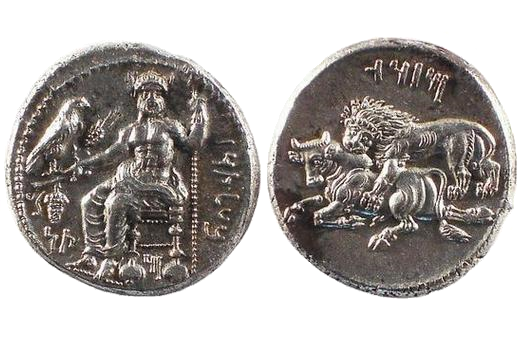
about ancient nomos
Ancient Nomos Art is a museum of galleries exhibiting ancient coins and ancient mint maps. The coin gallery displays the diverse art and history of hand-crafted ancient Greek, Roman, Byzantine, Persian and Medieval coinage. The ancient mints mapping gallery features Greek, Roman, Byzantine, Asia Minor and Medieval mint city regions and territories. Visitor's are welcome to explore, study and enjoy Ancient Nomos Art.

Persian Cilicia – 361 BC
Tarsos, Persia
From Ancient Galleries

Obverse: Baaltars seated left holding fertility wand, eagle, grapes and a sceptor.
Reverse: Lion attacking a bull from above with Cilician-Punic script above scene.
LEGEND SYMBOLS
Obv. Baaltars enthroned left, holding eagle, grain ear, grapes; scepter in left arm; Aramaic script ‘Ba’altarz’ to right; letters below seat and grapes. Rev. Lion attacking bull; Aramaic ‘Mazdai’ above.
Ancient Cilicia extends inland from the southeastern Mediterranean coast with low-lying fertile plains, fed by the Pyramus and Sarus rivers, and is flanked by the Tauros Mountains to the north. The coinage of Cilicia is considered municipal and satrapal or issued in the name of the Cilician governor at the time (see: Datames of Cilicia). The legends are in the Aramaic language, reflecting the regions mixed Greek and dominant Persian populations. The above coin was struck at Tarsos under Mazaeus, who was known as the “satrap” ruler of Cilicia beginning in 361 BC. The obverse image depicts Baal, the principal god of the region and known as Zeus by the Greeks. He is depicted enthroned facing left, wearing a type of kilt and crowned helmet and holds a lotus tipped staff in his left hand. He is holding in his right hand a stalk of grains, bundle of grapes, and staff with standing eagle. Taken together, these symbols signify the Cilician worship of Baal’s sacred religious powers and divine ability of prosperity through rich agricultural fertility and annual harvests. The Arameic legend “Ba’altarz” is inscribed to his left, with two sets of letters, one below the grapes and other under the seat. The reverse depicts a common ancient Persian motif of lion and bull in combat. The lion is seen bringing down the bull with its teeth and claws. It has been suggested this scene might be a sign of yearly renewal, or represent seasonal change, or even reflect the early Sumerian constellations Leo and Taurus (Hartner 1964-65). Others suggest the scene is symbolic of the sun’s daily victory over night (Lindsay 1971), as others suggest it may depict the conflict between King and his powerful but vanquished forces (Boyce 1982). This last reading appears most pertinent since the legend above reads ‘Mazaeus’ in Arameic, who is well known for successful battles against revolting Phoenicians, at a time when Cilicia came to symbolize the dominion of Persia over nearby hostile lands.
DOCUMENTATION
Value: Stater. Metal: AR Silver. Weight: 10.88 grams. Mint: Tarsos. Date: circa 361-334 BC.
Attribution: SNG Aulock 5959v.; SNG Cop. 311v.; SNG France 333-335; SNG Levante Supp. 20.
Legend, Documentation and Attribution
